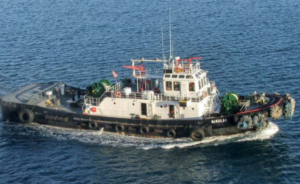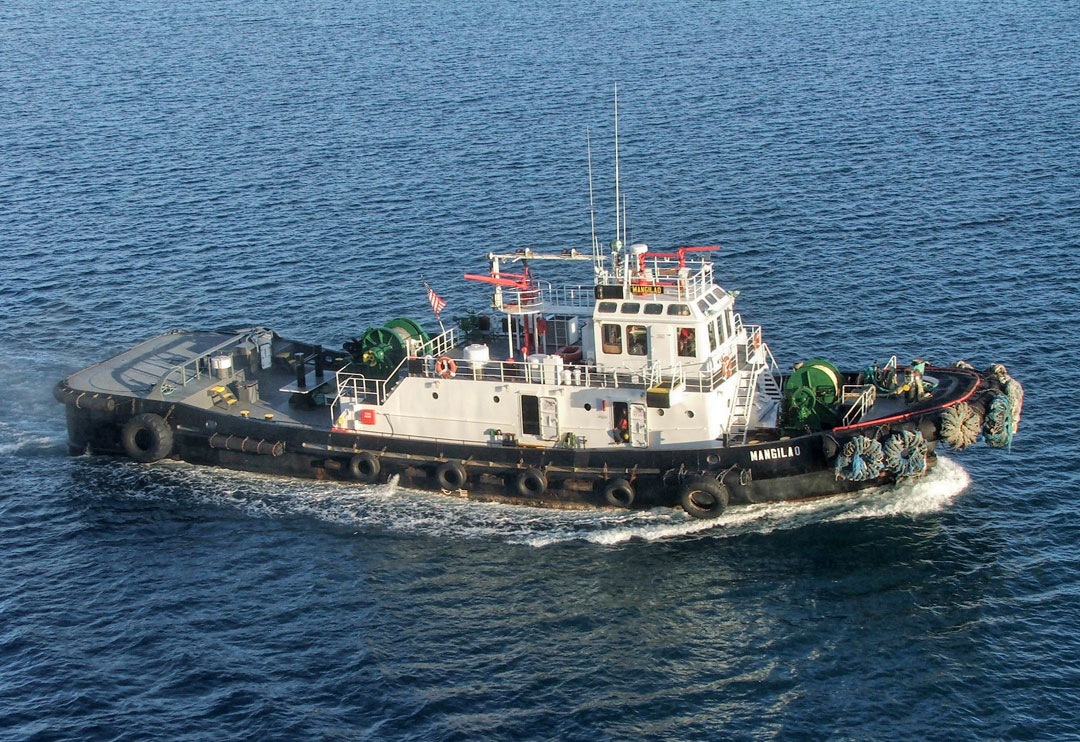Chamorro encountered 13-foot seas, heavy rain and 50-mph winds from a developing typhoon as it towed the unmanned tugboat Mangilao from Guam to the Philippines. While en route, the 1,700-hp oceangoing tug struggled to maintain speed in difficult conditions.

Before dawn on Aug. 5, 2019, the second mate on watch in the wheelhouse couldn’t see Mangilao’s navigation lights. He roused the chief mate, who asked another crewman to check the tug’s speed, which by then had jumped to 5.5 knots.
“The chief mate said that, at that point, he knew they had lost the tow,” the National Transportation Safety Board (NTSB) said in its accident report.
Chamorro’s crew located Mangilao after sunrise. It was listing to port and its port quarter was submerged. Chamorro’s captain considered it too dangerous to board the tug in hopes of stanching the flooding. The 37-year-old U.S.-flagged vessel sank at 0742 in the Pacific Ocean about 800 miles west of Guam.
Investigators determined the cotter pin on the 50-ton shackle securing Mangilao to other aspects of the towline broke or came loose, allowing the bolt’s securing nut to loosen.
“It is likely that the chain from the bitt on the foredeck of Mangilao was not long enough for the attached shackle to clear the fendering on the bow,” the NTSB said. “In heavy seas, as the vessel pitched and the bow of the vessel lifted up over the waves, the shackle likely made repeated contact with the fendering.”
Cabras Marine Corp. of Guam operated the 105-foot Chamorro and 107-foot Mangilao. The latter tug was bound for Subic Bay in the Philippines for dry-docking and repairs, including the addition of new watertight doors and fittings. Chamorro’s captain acknowledged that Mangilao’s watertight integrity was suspect.
U.S. Coast Guard personnel spent nearly two hours inspecting the two tugboats and reviewing the towing plan before departure. According to the NTSB report, Chamorro’s captain was anxious to leave, in part because of an approaching weather system. Days later, that storm became Typhoon Lekima.
Chamorro left Apra Harbor in Guam at about 1400 on July 29 for the 1,571-mile journey with 10 crew aboard. The tow was estimated to arrive on Aug. 8. The tug’s crew established a robust towing arrangement intended to survive a rough passage through open water. Solar-powered LED lights on Mangilao’s port, starboard and stern illuminated after dark.
The transit was mostly uneventful through late in the day on Aug. 3, at which time the Joint Typhoon Warning Center announced that a tropical cyclone could form in the next 12 to 24 hours. The burgeoning low-pressure system was forming “right over” the tow, the NTSB said. As predicted, conditions worsened on Aug. 4.
“At 0905, (the captain) called all hands to the wheelhouse for a safety briefing,” the report noted. “He directed the crew to extend the tow wire (from 1,000 feet) to about 1,400 feet, explaining that they were expecting to encounter some significant weather and that this would provide a smoother ride. About 15 minutes later, once the tow wire was extended, he ordered all crew off deck.”
The vessels soon encountered 10- to 13-foot seas, 50-mph winds and heavy rain. Visibility was poor, but the crew saw Mangilao pitching heavily in the waves. The chief mate, finishing his watch from 0000 to 0400 on Aug. 5, spotted Mangilao’s navigation lights at about 0340. The rain cleared for a time at 0420 and the second mate on watch could not see the tow. That’s when he woke the chief mate, who confirmed the tow was gone.
The crew first took to recovering the towing system. Working downwind, with seas washing over the deck, it took nearly 50 minutes to haul in the 2-inch towing wire. “The wire and the 14-inch tow pendant came aboard, but the crew noticed the shackle closest to Mangilao was missing its pin,” the report said.
Later that morning, Chamorro turned back and identified Mangilao on radar. At that point, with the tug’s port quarter under water, there was little Chamorro’s crew could do but watch it sink.
Investigators reviewing the incident noted the captain’s decision to set sail toward a developing storm. He later told the NTSB he felt confident making the voyage, in part because the weather routing service was available. The report confirmed the routing service guided the tug around the worst of the storm.
It’s not clear when Mangilao started taking on water. The NTSB noted the condition of its watertight fittings and suggested the vessel slowly flooded over several days before the encounter with the storm. The agency also suggested boarding seas could have dislodged one or more watertight fittings, increasing the rate of water ingress.
“If Mangilao was flooding, the added water weight would have put greater stress on the towing components,” the report said. “Once the towline arrangement for Mangilao failed, leaving it dead in the water, it is likely that seas more easily boarded the vessel and continued to flood it, leading to its eventual sinking.”
Casey Conley

